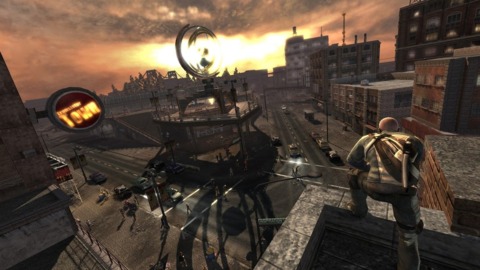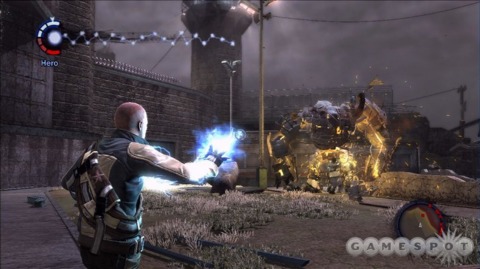Infamous director on cutting corners
GDC 2010: Sucker Punch's Nate Fox describes how his team built an open-world city with a small team by smartly reusing art assets.
Who was there: With the 2010 Game Developers Conference beginning in earnest today, Infamous game director Nate Fox from Sucker Punch delivered an early-morning session titled "Building an Open World Game Without an Army."

What they talked about: Sucker Punch achieved substantial critical praise for its PlayStation 3-exclusive Infamous upon the game's launch in May 2009. And given that the game has sold in excess of 1.2 million units, its commercial reception wasn't half bad either. However, the team that built the open-world action adventure was actually on the small side, according to Fox, as a mere 12 artists fleshed out Infamous' sprawling city.
Fox began his session by noting how indebted the open-world genre is to Rockstar's Grand Theft Auto III. Because of that game, players expect similar offerings that feature worlds that feel not only massive, but also content-rich with loads of interactivity. This kind of experience, of course, can be both complex to design and tremendously expensive to build, so it is important to plan ahead.
To adequately capture the open-world feel, Fox noted that it's important to give players areas of discovery or places that aren't immediately available to enter. He also said that players expect a large variety of environments when exploring a city, even though most real cities are largely homogeneous.
The way Sucker Punch went about delivering this type of experience was by heavily reusing assets, a point that was the crux of Fox's session. Specifically, Fox said that since the real world is largely manufactured, artists don't necessarily need to create more than a few streetlights, dumpsters, fire escapes, and the like.
Plus, by reusing assets, artists can spend less time modeling each and every city block and more time on the evil villain lairs and special one-off buildings that players are really interested in. And while city blocks still need some effort, it's important to note that players will largely be paying attention to the enemies that are shooting at them, not the bricks on the buildings.
To maximize reuse, Sucker Punch hit upon a hex-tile system to grid out Empire City, in a way common to board games, such as Settlers of Catan or Carcassonne. Basically, city sections are all built on a hex tile, which are then centered upon traffic intersections. Each edge on a hexagon was taken up by a road, alley, or elevated train line, so all developers had to do was make sure adjacent hexagon edges matched. The designers could then add the appearance of variety by taking clusters of hexagons, rotating or tweaking them slightly, and then pasting them down elsewhere in the city.

As for how structures are worked in, certain spaces in the hex tile are allocated for building use. These spaces were first fleshed out with generic building types, and the artists then went into each tile to create unique structures where it seemed appropriate or time permitted. Further, Fox said that buildings had preset holes carved into them, and artists could mix and match these to provide more variety. Again, the reuse allowed Sucker Punch's artists to spend more time on what players would actually be paying attention to, such as signage.
Fox also discussed the ways in which Sucker Punch made Empire City feel bigger, as well as give the sense of rapid movement. Namely, the team worked to eliminate straight line of sight by always using Y-intersections, a product of the hex-tile system. The Y-intersections are useful because they block line of sight, are ideal for camera navigation, and provide players with rewarding reveals.
He said that it's also important to include a variety of "weenies" or high-profile spots that serve as landmarks for certain neighborhoods. By reusing building types and other architecture early on, the team had more time to construct these iconic structures, he said.
Gated content is also key to making an open-world city feel larger, he said. If players have lots of content to explore initially but then are able to look out over, say, a waterway to see more content, they will eventually be able to access and it gives the impression that the city is huge. He also said that collectible items are a good way to get players to fully explore the content in a city because the easy-to-place packages can be put anywhere and consequently lead players to where they wouldn't normally go.
Fox concluded his presentation by going over some of the drawbacks related to the hex-tile system of reuse. Namely, the predefined building locations can result in odd-shaped structures, which can have a negative impact on the realism of the city. Also, players are more likely to get turned around or lost at Y-intersections, and the dearth of 90-degree thoroughfares is fairly unrealistic. He also said that the space between buildings and alleys is standardized, further impacting immersion.
Quote: "The world we live in is manufactured, why not go with it?"--Nate Fox on the virtues of reusing art assets.
Takeaway: Sucker Punch was able to successfully create an open-world city with a relatively small team, largely by smartly reusing certain assets. By recycling much of the art content, the team was able to spend more time on what players actually noticed and cared about, such as iconic structures and one-off enemy lairs, and less time getting mired in the nitty-gritty city block design.
The Complete FALLOUT Timeline Explained! Warhammer 40k: Darktide - Path of Redemption | Update Trailer Is Fallout 76 Good in 2024? SAND LAND - Official Darude Sandstorm Trailer No Rest for the Wicked - Official Steam Early Access Launch Trailer Battlefield 2042 | Frontlines Mode Returns - Time-Limited Event Trailer 21 Details You May Have Missed In Helldivers 2 Stellar Blade - Official "The Journey" Behind The Scenes Trailer | PS5 Games Zenless Zone Zero - Official Koleda Character Teaser Trailer | "Bite At The Site" PUBG MOBILE | SPYxFAMILY Collaboration LIVE Now! Genshin Impact | Version 4.6 "Two Worlds Aflame, the Crimson Night Fades" Trailer The 11 Creepiest Vaults Of Fallout
Please enter your date of birth to view this video
By clicking 'enter', you agree to GameSpot's
Terms of Use and Privacy Policy
Got a news tip or want to contact us directly? Email news@gamespot.com
Join the conversation